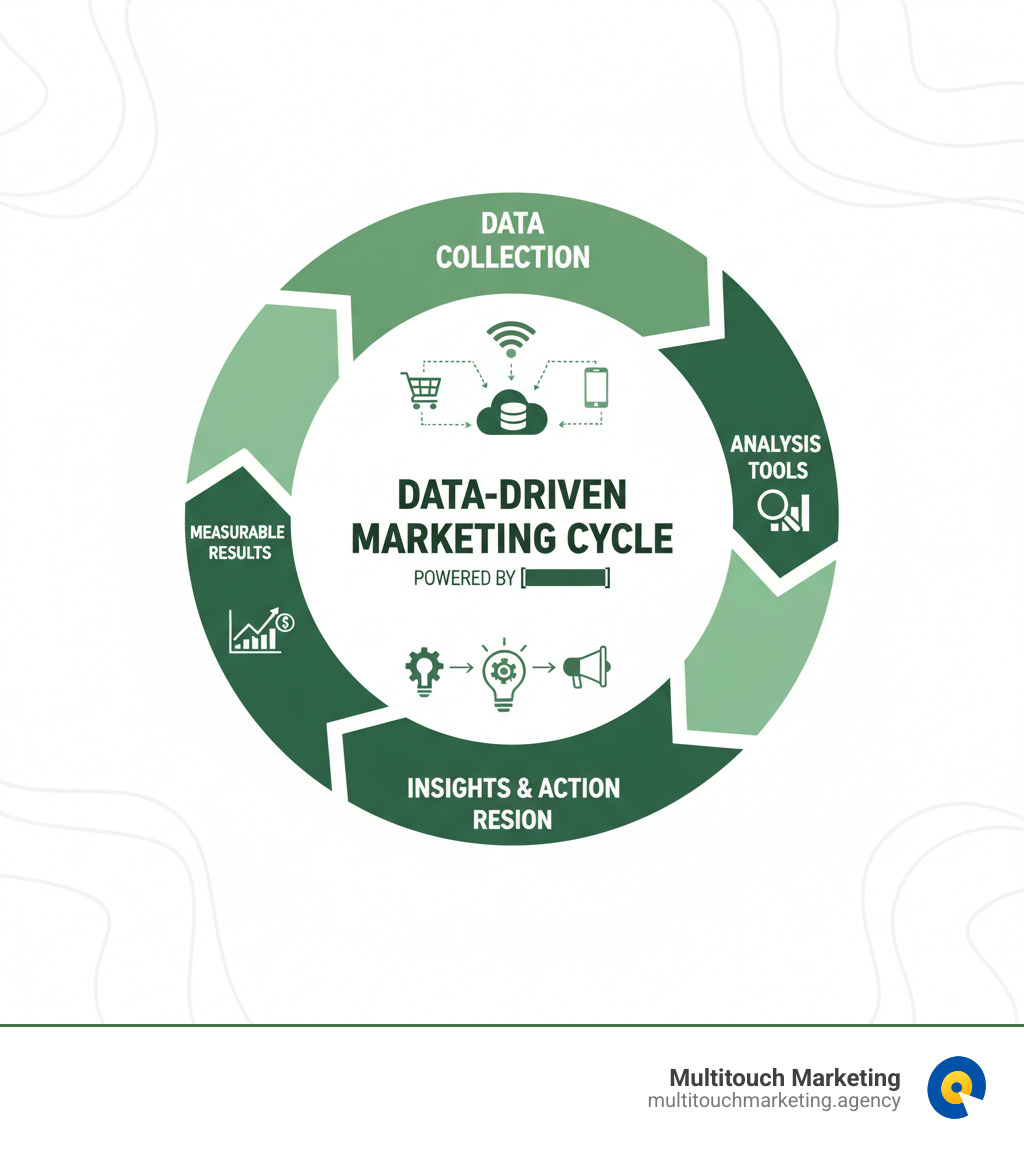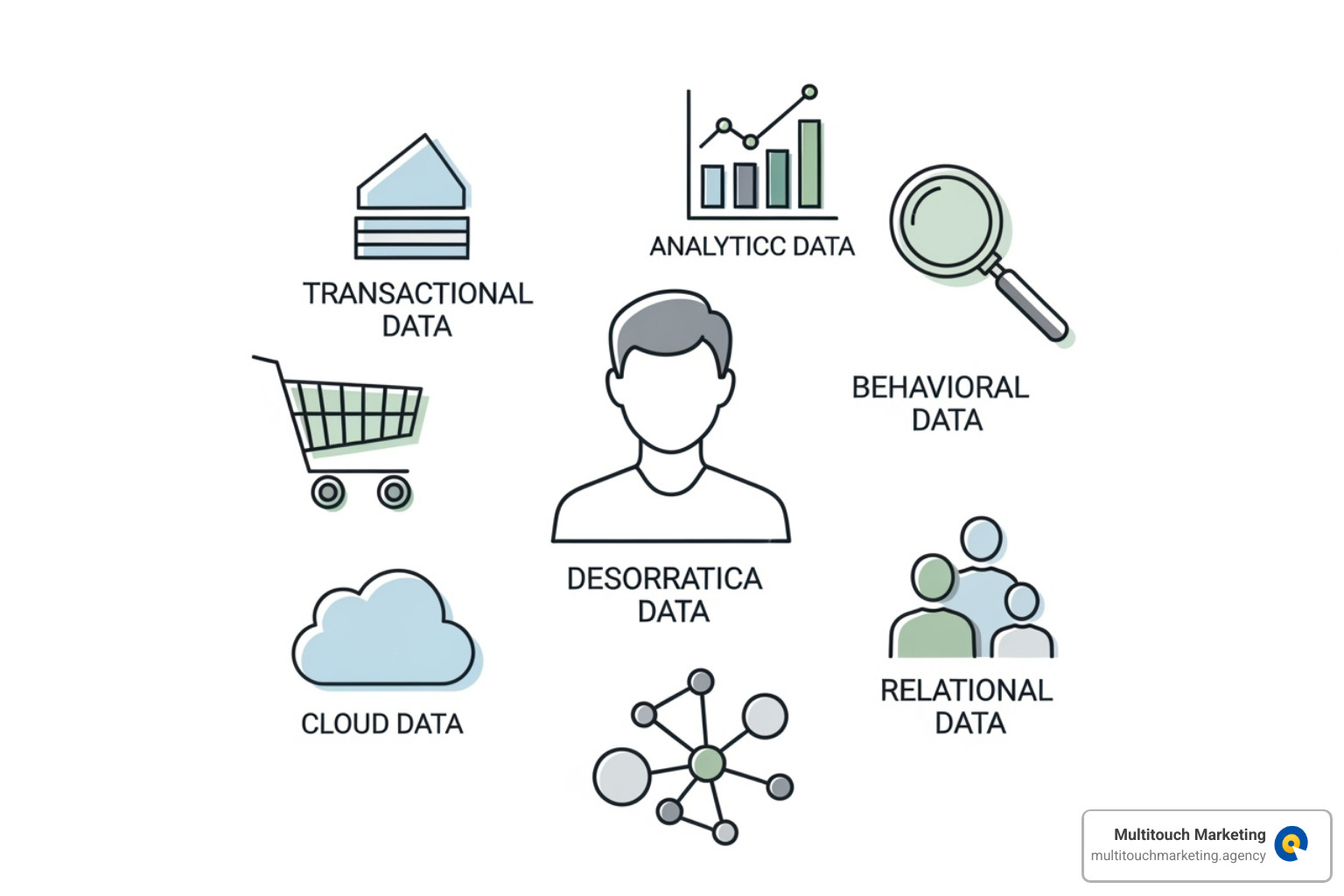Why Data-Driven Marketing is the Future of Business Growth
Data-driven marketing is a strategic approach that uses customer information and analytics to guide marketing decisions, optimize campaigns, and predict future behaviors for better business results.
Key Components of Data-Driven Marketing:
- Data Collection: Gathering customer information from websites, social media, emails, and purchases
- Analysis: Using tools to understand patterns and customer behavior
- Action: Creating targeted campaigns based on insights
- Measurement: Tracking results to improve future marketing efforts
The numbers tell a compelling story. While traditional marketing relied on assumptions and gut feelings, today’s successful businesses accept data. In fact, 2 out of 3 leading marketers admit that data-based decisions beat gut instinct every time.
This shift isn’t just about having more information – it’s about using that information to create better customer experiences. When 71% of consumers expect personalized interactions and 79% won’t consider offers that aren’t custom to their previous interactions, the stakes are clear.
The reality is stark: businesses using data-driven strategies report 5 to 8 times higher ROI from their marketing efforts compared to those that don’t. Yet 81% of marketers still find implementing these strategies extremely complicated.
The good news? It doesn’t have to be overwhelming. With the right approach, even small businesses can harness the power of data to compete with larger competitors and build stronger customer relationships.
I’m Milton Brown, and I’ve spent over 15 years helping organizations transform their marketing through data-driven methodologies, managing campaigns from $20,000 to $5 million budgets across industries from healthcare to e-commerce. Data-driven marketing has consistently delivered measurable results for every client I’ve worked with, and I’ll show you exactly how to make it work for your business.
What is Data-Driven Marketing and How Does It Work?
Picture this: you’re running a restaurant and trying to decide what specials to offer. The old way? You’d guess based on what you like or what seemed popular last month. Data-driven marketing is like having a crystal ball that tells you exactly what each customer craves before they even walk through your door.
This approach flips traditional marketing on its head. Instead of casting a wide net and hoping for the best, we use real customer information to make smart, targeted decisions. It’s the difference between shouting into a crowded room and having a personal conversation with someone who’s genuinely interested in what you’re saying.
Defining the Modern Approach
The original premise of marketing has always been about understanding what customers need and delivering solutions. But here’s where things get interesting: for decades, marketers relied on focus groups, surveys, and educated guesses to figure out those needs.
Don’t get me wrong – experience and intuition still matter. But when you can combine that human insight with hard data about how customers actually behave? That’s when the magic happens.
Think of traditional marketing like planning a surprise party based on what you think someone likes. Data-driven marketing is like secretly checking their Pinterest boards, Amazon wish list, and recent Google searches first. You’re still planning with care and creativity, but now you have insider knowledge.
The numbers back this up beautifully. 2 out of 3 of the leading marketers now admit that data consistently beats gut instinct. And honestly, this makes perfect sense. Why guess when you can know?
This shift has opened up incredible possibilities. We can now predict what customers might want next, personalize messages for thousands of people at once, and measure exactly what’s working. For businesses ready to accept cutting-edge approaches, AI-Driven Marketing Strategies show how technology can boost these data-first methods.
Here’s how the two approaches stack up:
| Traditional Marketing | Data-Driven Marketing |
|---|---|
| Mass messaging | Personalization |
| Assumptions | Data insights |
| Low measurability | High measurability |
| Reactive | Proactive |
| Trial and error | Optimized and iterative |
The Building Blocks: Types of Marketing Data
Now, let’s talk about the fuel that powers data-driven marketing: the data itself. We’re living in an incredible time – experts predict we’ll create, store, and use about 181 zettabytes of data by the end of 2025. That’s more information than we could process in several lifetimes!
But not all data is created equal. Think of it like ingredients in a recipe – you need the right mix to create something delicious.
Demographic data tells us who our customers are. This includes basics like age, gender, income, education, and location. Sources like the U.S. Census Bureau provide valuable public information that we can combine with our own customer details. Imagine you’re selling luxury watches – knowing the average income in different zip codes helps you focus your ads where they’ll have the biggest impact.
Behavioral data reveals what customers actually do, not just what they say they’ll do. This covers website visits, clicks, time spent browsing, search queries, and how they interact with emails or ads. It’s like having a security camera that shows you exactly how customers move through your digital store.
Transactional data zooms in on the money moments – what people buy, when they buy it, how much they spend, and how often they come back. This information is pure gold for understanding customer value and spotting patterns that predict future purchases.
Predictive data is where things get really exciting. This isn’t raw information but insights created by analyzing huge datasets with smart algorithms. It helps us forecast what customers might do next – like whether they’re likely to buy, cancel their subscription, or respond to a special offer.
First-party data comes directly from your own customers through your website, app, or CRM system. This is your most valuable asset because it’s unique to your business and reflects real relationships with your customers.
Third-party data is information collected by other companies and sold to marketers. While it can provide broader audience insights, it’s less precise and comes with more privacy concerns.
When you blend these different data types together, you create a complete picture of your audience. It’s like assembling a jigsaw puzzle – each piece adds clarity until you can see the whole image and make marketing decisions that truly connect with your customers.
The Core Benefits of a Data-First Approach
When you accept data-driven marketing, you’re not just keeping up with the competition – you’re positioning your business for remarkable growth. The payoff from focusing on data first is huge, and the results speak for themselves.
Think about it this way: every piece of customer data is like having a conversation with your audience. They’re telling you what they want, when they want it, and how they prefer to receive it. When we listen to these signals and act on them, magic happens.
Increased ROI is often the first benefit businesses notice. Instead of throwing marketing budgets at the wall and hoping something sticks, data shows us exactly where to invest. We can optimize campaigns in real-time, allocate budgets to the channels that actually work, and ensure every marketing dollar pulls its weight.
Better decision-making becomes second nature when you have solid data backing your choices. No more late-night debates about whether that new campaign will work – the numbers tell the story. We can identify what’s working, what’s falling flat, and most importantly, why. This means we can pivot quickly when something isn’t performing and double down on what’s driving results.
The competitive advantage is undeniable. While other businesses are still guessing what their customers want, data-driven companies are already delivering it. When you can connect with customers on a deeper level and consistently optimize your performance, you naturally pull ahead of the pack.
Perhaps most importantly, data-driven marketing leads to improved customer loyalty and satisfaction. When we truly understand our customers, we can create experiences that genuinely delight them. This builds stronger relationships, encourages repeat business, and turns customers into advocates who spread the word about your brand.
Achieve True Personalization at Scale
We’ve all rolled our eyes at that generic email with our first name awkwardly inserted in the subject line. That’s not real personalization – that’s just mail merge with good intentions. True personalization, powered by data, goes so much deeper.
Real personalization is about delivering the right message to the right person at exactly the right moment through their preferred channel. It’s like having a personal shopping assistant for every single customer, except this assistant never forgets their preferences and is available 24/7.
Customer segmentation becomes incredibly sophisticated with data. Instead of broad categories like “all car owners,” we can target “electric vehicle owners in urban areas who regularly engage with sustainability content and have a household income above $75,000.” This level of precision means our messages hit home every time.
Targeted messaging flows naturally from these detailed segments. When we know someone’s interests, behaviors, and preferences, we can craft messages that feel like they were written just for them. And honestly, in a way, they were. No more irrelevant ads that make customers feel like we don’t understand them at all.
The numbers back this up powerfully. 71% of consumers now expect this level of personalization. It’s not a nice-to-have anymore – it’s table stakes for staying competitive.
Personalized customer journeys take this even further. By tracking how customers interact with us across multiple touchpoints, we can create seamless experiences that feel effortless. Think dynamic website content that changes based on previous visits, product recommendations that actually make sense, or perfectly timed discount offers that arrive just when someone’s considering a purchase.
For businesses looking to take this to the next level, exploring AI-Improved Customer Experience can open up even more sophisticated personalization capabilities.
Maximize ROI and Optimize Spend
Here’s where data-driven marketing really shows its value in dollars and cents. Every marketing budget has limits, and data helps us make sure every dollar works as hard as possible.
Attribution modeling solves one of marketing’s biggest mysteries: which touchpoints actually contribute to sales? Was it that first social media ad, the nurture email sequence, or the final PPC click that sealed the deal? Data lets us assign credit accurately, so we stop throwing money at channels that look good but don’t actually drive results.
Channel optimization becomes straightforward when we have performance data from all our marketing efforts. We can see which channels work best for different goals and audience segments, then shift our spending accordingly. It’s like having a GPS for your marketing budget – always pointing you toward the most efficient route.
Budget allocation transforms from guesswork into strategy. With clear data showing what drives conversions and revenue, we can make confident decisions about where to invest. No more wondering if that expensive trade show was worth it or if we should have spent more on digital ads.
A/B testing becomes our constant companion. We continuously test different versions of ads, landing pages, emails, and calls-to-action to see what resonates best with our audience. This iterative approach, guided by solid data, leads to steady improvements and higher conversion rates over time.
The results speak for themselves: Businesses that use personalization deliver 5x – 8x higher ROI from their marketing efforts compared to those flying blind.
For businesses ready to dive deeper into the analytics side, AI in Marketing Analytics offers powerful tools to accelerate testing and uncover insights that might take months to find manually.
Implementing Your Data-Driven Marketing Strategy
So, how do you actually implement data-driven marketing? It’s not about collecting mountains of data; it’s about building a strategic framework that weaves data into every marketing decision.
Implementing this strategy is like building a house: you need a solid foundation. This means clear strategic planning outlining what you want to achieve, measurable goals to track success, and Key Performance Indicators (KPIs) to act as your compass.
This approach fosters an environment where every campaign decision, budget allocation, and creative choice is informed by real customer insights. For businesses ready to build these frameworks, our guide on Data-Driven Marketing Strategies walks through the process step by step.
Common Challenges and How to Overcome Them
If data-driven marketing were easy, everyone would master it. But the reality is that 81% of marketers find implementing these strategies “extremely complicated.” Let’s look at the common challenges and how to tackle them.
Data silos are a major headache. When your analytics, email, sales, and social media data are in different platforms, you can’t get a complete customer view. In fact, 69% of organizations struggle with this because their data is so scattered. The fix is to unify your data. Customer Data Platforms (CDPs) act as a central hub, but you must also break down departmental walls to ensure everyone speaks the same data language.
Then there’s the poor data quality problem. The saying “garbage in, garbage out” is painfully true in marketing. With only 3% of companies’ data meeting basic quality standards, many businesses risk making major decisions based on flawed information. The solution is strong data governance. Implement regular audits, cleaning processes, and validation rules to catch errors before they contaminate your insights.
Lack of skills and expertise is another roadblock. You don’t necessarily need a data scientist, but someone on your team must be able to turn raw numbers into actionable insights. This may require training existing staff, hiring specialized talent, or partnering with experts.
Finally, there’s implementation complexity. The sheer volume of data, countless tools, and rapid technological change can be overwhelming. While 70% of marketing executives say it’s important, only about 2% have seen positive results from their investments. The secret is to start small and build incrementally. Pick one specific goal, focus on the data that impacts it, and prove the concept before expanding.
Essential Tools and Technologies
Implementing data-driven marketing requires the right toolkit. You don’t need every new platform, just the ones that solve your specific problems and work well together.
Customer Relationship Management (CRM) systems like Salesforce or HubSpot are the backbone of data strategies. They track customer interactions, manage sales pipelines, and store behavioral data for personalization.
Data analytics platforms like Google Analytics are essential for insights into traffic, user behavior, and conversion paths. For more complex needs, Adobe Analytics or Matomo offer deeper customization.
Data visualization tools like Google Data Studio, Tableau, and Power BI transform spreadsheets into understandable dashboards and interactive reports.
Marketing automation platforms like ActiveCampaign or ConvertKit automate actions based on data insights, triggering personalized communications based on customer behavior.
Customer Data Platforms (CDPs) are increasingly important for unifying customer information from multiple sources. They create comprehensive customer profiles for use across all marketing channels.
Testing and optimization tools like Optimizely and VWO are invaluable for validating hypotheses with real user data, so you’re not just guessing what works.
The landscape keeps evolving, especially with advances in AI Technology for Marketing. The key is choosing integrated tools that provide the insights you need and fit your budget and team capabilities.
Examples of Successful Data-Driven Marketing
The best way to understand data-driven marketing is to see it in action.
Netflix has mastered personalization. They collect vast data on viewing habits to power their recommendation engine, which is core to their business model. How Netflix uses analytics to select content shows how data is their foundation.
Amazon uses browsing history, purchases, and searches to feed its recommendation system. Suggestions like “customers who bought this also bought” are calculated predictions to increase cart value, creating a near-telepathic shopping experience.
Spotify’s Find Weekly is data-driven genius. By analyzing listening habits, skips, and saves, it creates a personalized playlist each week, acting like a music-savvy friend powered by a sophisticated algorithm.
Starbucks uses its mobile app and rewards program to collect data on preferences and purchase patterns. This allows for personalized offers and recommendations based on factors like time of day, increasing convenience and average order value.
For example, Philips used analytics and AI to optimize its website. A simple slide-in call-to-action increased newsletter signups by 635%, while removing video auto-play improved product page views by 15.85%. These smart, data-informed tweaks delivered massive results.
An online bookstore used browsing and purchase behavior for personalized email recommendations, resulting in a 290% increase in open rates and an 80% conversion rate. Showing people what they want works.
Conversely, ignoring data can be costly. Tropicana redesigned its packaging based on gut instinct, lost $30 million in sales, and had to revert to the original design. It’s a powerful reminder that even established brands need data to guide their decisions.
The Ethical Compass: Data Privacy and Transparency
Here’s the reality we can’t ignore: data-driven marketing comes with serious responsibilities. When we collect and use customer information, we’re not just handling numbers and statistics – we’re dealing with real people’s personal details, preferences, and trust.
The numbers paint a clear picture of what’s at stake. A staggering 79 percent of customers will completely stop doing business with a company if they find their personal data is being collected and used without their knowledge. That’s not just a small portion of upset customers – that’s nearly four out of five people walking away from your business entirely.
Building genuine customer trust starts with transparency. We need to be completely upfront about what data we’re collecting, why we need it, and exactly how we plan to use it. Think of it like this: when customers understand the value exchange – that sharing their information leads to more relevant offers, better service, or personalized experiences – they’re much more willing to participate.
The key is making this exchange feel fair and beneficial to them, not just to us.
Data security isn’t optional – it’s absolutely non-negotiable. Every data breach that makes headlines erodes trust across the entire industry. We must implement robust security measures to protect customer information from breaches, misuse, and unauthorized access. This isn’t just about avoiding bad publicity; it’s about honoring the trust customers place in us when they share their personal details.
Compliance with privacy regulations has become increasingly complex but critically important. The General Data Protection Regulation (GDPR) in Europe and similar laws like the California Consumer Privacy Act (CCPA) have fundamentally changed how businesses must handle customer data. These regulations give consumers more control over their personal information, including the right to access what data companies have about them, correct inaccuracies, and request complete deletion.
Beyond just following the law, smart businesses accept these principles because they build stronger customer relationships. When we give customers easy ways to manage their preferences, opt out of communications they don’t want, or update their information, we’re showing respect for their autonomy and choices.
The most successful data-driven marketing strategies create a win-win situation. Customers receive more relevant, useful experiences, while businesses gain the insights they need to serve those customers better. This ethical approach isn’t just the right thing to do – it’s also the most sustainable way to build long-term business success in our data-driven world.
Start Measuring Up with Multitouch Marketing
We’ve journeyed through data-driven marketing together, exploring everything from basic definitions to advanced implementation strategies. The landscape is clear: marketing’s future belongs to those who accept data over guesswork, insights over assumptions, and measurable results over crossed fingers.
The change isn’t just about having better tools or more sophisticated dashboards. It’s about fundamentally changing how we connect with our customers. When we use data thoughtfully, we stop interrupting people with irrelevant messages and start providing genuine value at exactly the right moment.
Data-driven marketing has proven its worth across industries and business sizes. From Netflix’s recommendation engine to local businesses personalizing their email campaigns, the principles remain the same: collect meaningful data, analyze it for actionable insights, and use those insights to create better customer experiences.
At Multitouch Marketing, we’ve seen how data transforms PPC campaigns from expensive experiments into precision instruments for growth. Our team understands that every click, conversion, and customer interaction generates valuable data that can optimize future performance.
Based in the Research Triangle area of North Carolina – serving Raleigh, Durham, and Chapel Hill – we specialize in turning your PPC data into competitive advantages. Whether you’re struggling with attribution modeling, need help with customer segmentation, or want to maximize your advertising spend, we bring data-driven marketing expertise to every campaign we manage.
The beauty of data-driven PPC lies in its measurability. Unlike traditional advertising where results remain fuzzy, digital campaigns provide crystal-clear feedback. We can track which keywords drive conversions, which ad copy resonates with different audience segments, and which landing pages turn visitors into customers.
This precision extends beyond just PPC. Smart businesses today integrate their paid advertising data with other marketing channels to create comprehensive customer journeys. If you’re ready to expand your data-driven approach beyond paid ads, our guide on how to Learn how to improve your social media marketing shows how the same principles apply across platforms.
The future of marketing isn’t just data-driven – it’s here right now. The question isn’t whether your business should accept this approach, but how quickly you can start implementing it. Every day you wait is another day your competitors might be gaining ground through smarter, more targeted marketing efforts.
Ready to transform your marketing from guesswork into a growth engine? Let’s start measuring what matters and turn your data into your biggest competitive advantage.




